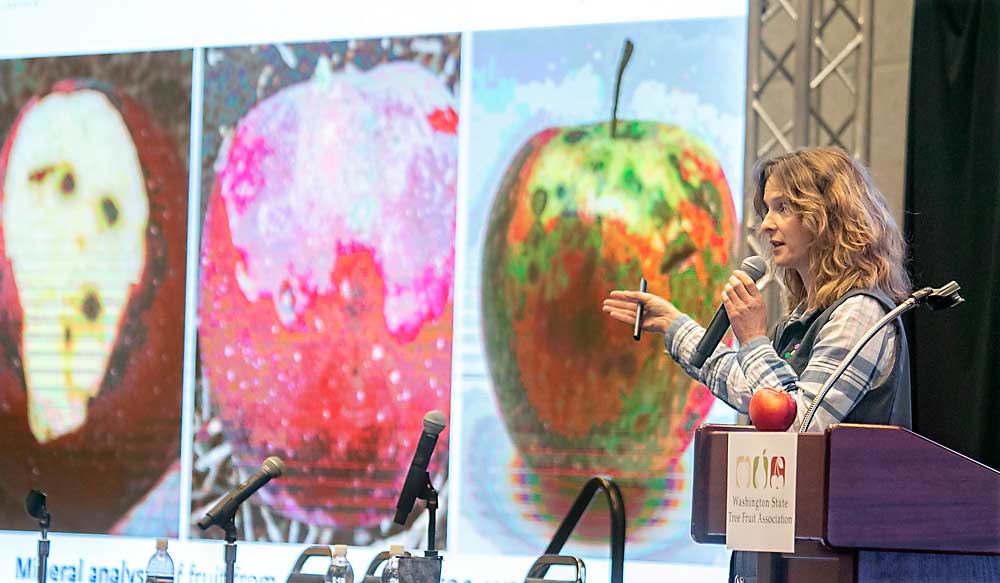
Ines Hanrahan, executive director of the Washington Tree Fruit Research Commission, speaks about disorders in Cosmic Crisp at the Washington State Tree Fruit Association’s annual meeting in December 2018. (TJ Mullinax/Good Fruit Grower)
In 1969, facing an uncertain labor supply and an urgent need for mechanization, Washington growers were asked to vote on starting a commission that would help to finance and encourage the research needed to improve production and reduce costs of locally grown fruits.
The Aug. 15, 1969, issue of Good Fruit Grower magazine reported growers approved the formation of the Washington Tree Fruit Research Commission by a 2-1 margin, with 1,359 votes for and 687 against. The commission was initially funded with a 10-cent-per-ton assessment on all Washington-grown tree fruit.
Now celebrating its 50th anniversary, the commission remains focused on its mission to provide science-based solutions for an innovative and profitable tree fruit industry.
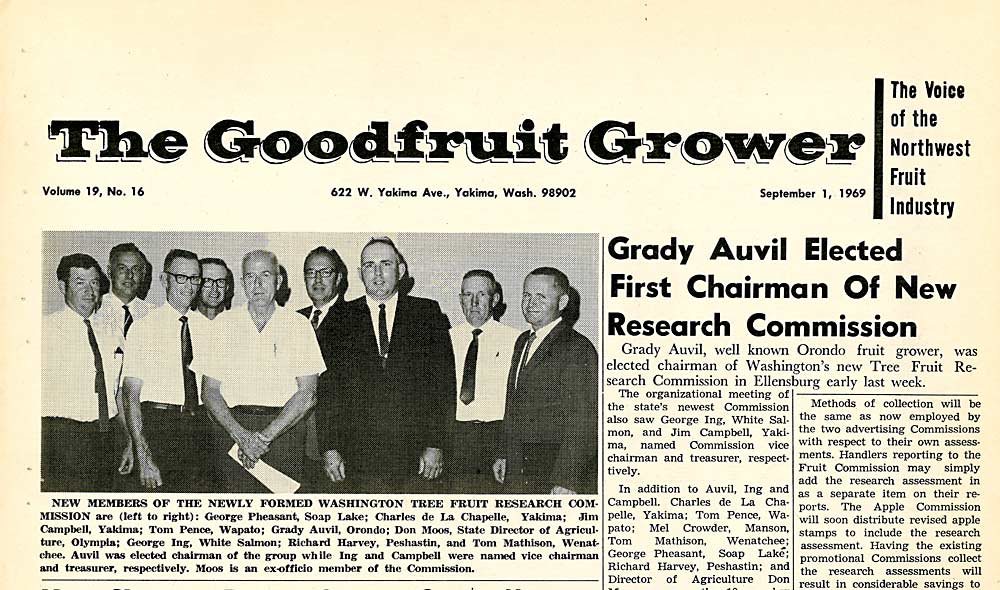
In August 1969, Washington growers voted in favor of forming the Washington Tree Fruit Research Commission, with funding to come from a 10-cent-per-ton assessment on all Washington-grown tree fruit. The 10-member board of commissioners was announced in the Sept. 1, 1969, issue of Good Fruit Grower (known at the time as The Goodfruit Grower). (Good Fruit Grower archive)
In addition to funding research, the commission provides research and extension support, represents the industry’s interests from a science-based perspective, provides industry leadership and serves as a catalyst to connect industry partners with the scientific community.
Ines Hanrahan, the commission’s executive director, emphasizes that its mission includes all growers in the state, large and small. “We will utilize science to provide solutions for the industry so that every grower can use this technology in order to stay profitable,” she said.
WTFRC currently has a staff of nine employees and a nine-member board of commissioners.
To celebrate and demonstrate its critical impact on the industry over the years, the commission is highlighting three of its major successes: codling moth control with mating disruption, 1-MCP (1-methylcyclopropene) technology and chemical blossom thinning.
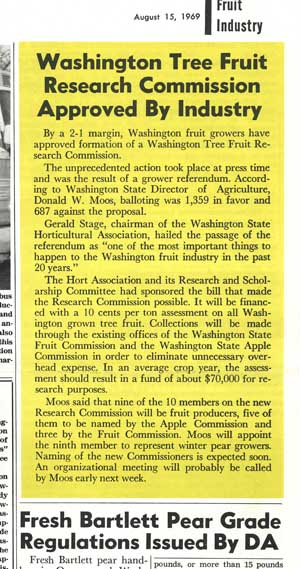
With an uncertain labor supply and a need for automation in production tasks, Washington growers in 1969 voted 2-1 in favor of the commission. (Good Fruit Grower archive)
“Each had significant investment; the first two (codling moth and 1-MCP) over $2 million and the chemical bloom thinning about $700,000,” Hanrahan said.
Articles on each of these stories will run in upcoming issues of Good Fruit Grower. The commission is also creating three short videos featuring these topics. The videos will be released later this summer.
However, those are only a few of the ways the commission has supported the industry.
Robotic harvesting is another area where commission support has been crucial, including the vision robotics automated harvester from Abundant Robotics, now in its first commercial use in New Zealand. The robotic harvester will operate in Washington orchards this fall.
Hanrahan said the company’s developers have been working with the Washington tree fruit industry throughout their development process, and “the initial funding came from the foresight of our board.”
The commission is also funding a group out of Israel that is working on a different robotic harvest concept, “because we understand that having two pickers that work is better than one,” she said.
In 2004, the commission published its first technology roadmap identifying two main areas for research: genetics and breeding, and automation technology. The roadmap was created to identify research priorities and with a guiding vision of creating a profitable tree fruit industry with a prosperous workforce, operating more efficiently, under safer conditions, with higher-paying, year-round jobs.
The commission is currently developing an updated technology roadmap focused on automation and robotics and is also working on an organic roadmap to identify areas of need for the state’s growing number of organic producers.
“These roadmaps are very helpful because they provide clear guidance to the scientific community and educate people on what are the most important areas where we need research,” she said.

George Ing in September 1990. Ing was the first employee of the Washington Tree Fruit Research Commission and led the commission from 1969 to 1999. (Good Fruit Grower file photo)
Funding process
Over its 50-year history, the WTFRC has administered more than $120 million to support more than 800 research projects.
Funds are collected on a per-ton assessment, so bigger crops mean more money for research. There are currently five advisory committees set up — cherry, stone fruit, apple horticulture and postharvest, apple crop protection and technology. “Pear is a little different,” Hanrahan said. “We are administering pear funding and research for the Federal Marketing Order, which was set up in 2005, and are not collecting pear assessments right now.”
Each year, the advisory committees set the research priorities and communicate those to the researchers.
Research reviews are held annually, typically starting with the cherry and stone fruit research reviews in November, the two apple reviews in January and a technology review in February. The Northwest pear research review is also held in February. The respective advisory committees review the proposals and recommend the funding to the board. The board ultimately approves the funding of new projects.
The commission also provides start-up funding for new scientists. “Every new scientist is encouraged to submit a proposal for funding consideration to help them get going,” she said.
Commission leadership
Since its inception, the commission has had four leaders: George Ing from 1969 to 1999; Jim McFerson from 1999 to 2016; Mike Willett from 2016 to 2018; and now Hanrahan.
“George was the first employee of the Washington Tree Fruit Research Commission and oversaw the development of the commission structure,” Hanrahan said. “He had a clear vision of what it would potentially take to find the people to work on our problems.”
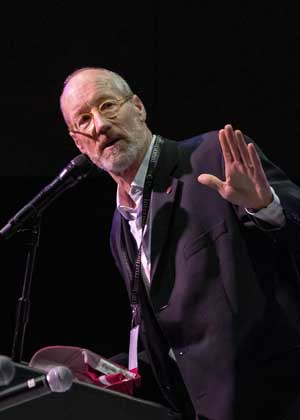
Jim McFerson gives the 37th Batjer Address at the 112th Annual Meeting and Northwest Hort Expo in December 2016. McFerson led the Washington Tree Fruit Research Commission from 1999 to 2016. (TJ Mullinax/Good Fruit Grower)
McFerson’s leadership drove the commission to the next level, Hanrahan said. He was an integral part of setting up the federal Specialty Crop Research Initiative grants now in use by the research community. “Because of that, researchers have obtained millions and millions of dollars in money for research in this region that otherwise would never have been available,” she said. The first technology roadmap was also developed under McFerson’s leadership.
Formerly the vice president for scientific affairs at the Northwest Horticultural Council, Willett assumed leadership of the commission after McFerson accepted a position as director of WSU’s Tree Fruit Research and Extension Center in Wenatchee.
“Mike came during a transitional period,” Hanrahan said, “while the board went through a very formal process of trying to find a new executive director.” Willett helped streamline many policies and procedures and worked to set up the commission for the next shift in leadership. He will retire in June.
After an international search that netted hundreds of applicants, the WTFRC board interviewed four highly qualified candidates and ultimately selected Hanrahan to lead the commission in August 2018. She was already working for the commission as a project manager, hired in 2005 after earning a doctorate in postharvest physiology at Washington State University.
Looking ahead
One of Hanrahan’s goals is to find ways to integrate research and development personnel at bigger companies and use that capacity in order to drive research in the tree fruit industry.
“You have to find common ground where other areas are noncompetitive in nature,” she said, citing food safety as an example. “Food safety is very important to the entire industry. It does not create a competitive advantage to be good at it. We believe you have to help lift everybody up in order to keep the entire industry viable.”
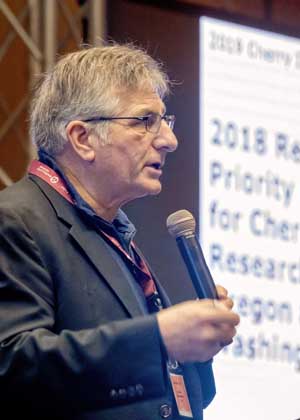
Mike Willett, manager of the Washington Tree Fruit Research Commission, talks about the need for a cherry research survey of growers in Washington and Oregon during the annual Cherry Institute in Yakima, Washington, in January. (TJ Mullinax/Good Fruit Grower)
With much of Washington growers’ attention focused on the first commercial harvest of WA 38 this fall, the commission is working closely with WSU and the tree fruit extension team to make available the most pertinent information for Cosmic Crisp. “We all want this to succeed,” Hanrahan said, noting that they are in the last phase of developing a starch scale, have been involved in helping to create grading standards and are creating requests for research specifically for the variety.
Cherry virus is another issue of immediate concern. “It’s a big emerging problem, so we have initiated the formation of a task force to provide immediate assistance to growers this year,” she said. “We have funded several research projects in this area, and we have an out-of-cycle project we are considering now for funding, because it’s so important.”
The commission is also revising its process for conducting research reviews. “Our main goal is to give researchers a clear idea of what we need in the industry to enable them to write better proposals and for us to be able to fund proposals that are more geared toward what we really need,” she said.
This focus on innovation and improvement continues to drive the commission’s success and helps ensure it meets its mission.
“The WFTRC will continue to be a platform for building a community that sparks ideas and inspires solutions, but above all, engages industry members to actively participate in creating their future,” Hanrahan said. “Everyone can get involved and should get involved. This is your organization. This is your money. You need to decide what you want to do with it.” •
—by Jonelle Mejica
Related: On the road to tech






Leave A Comment